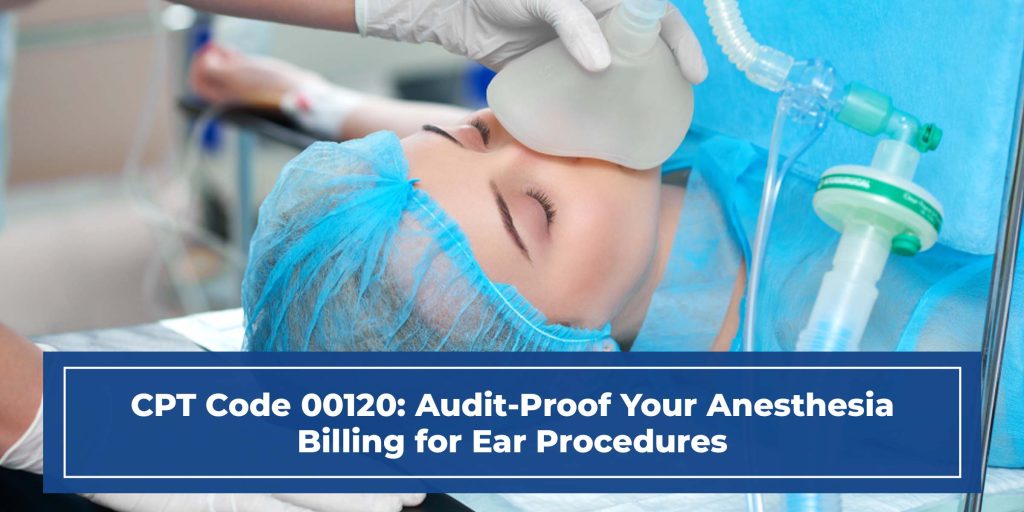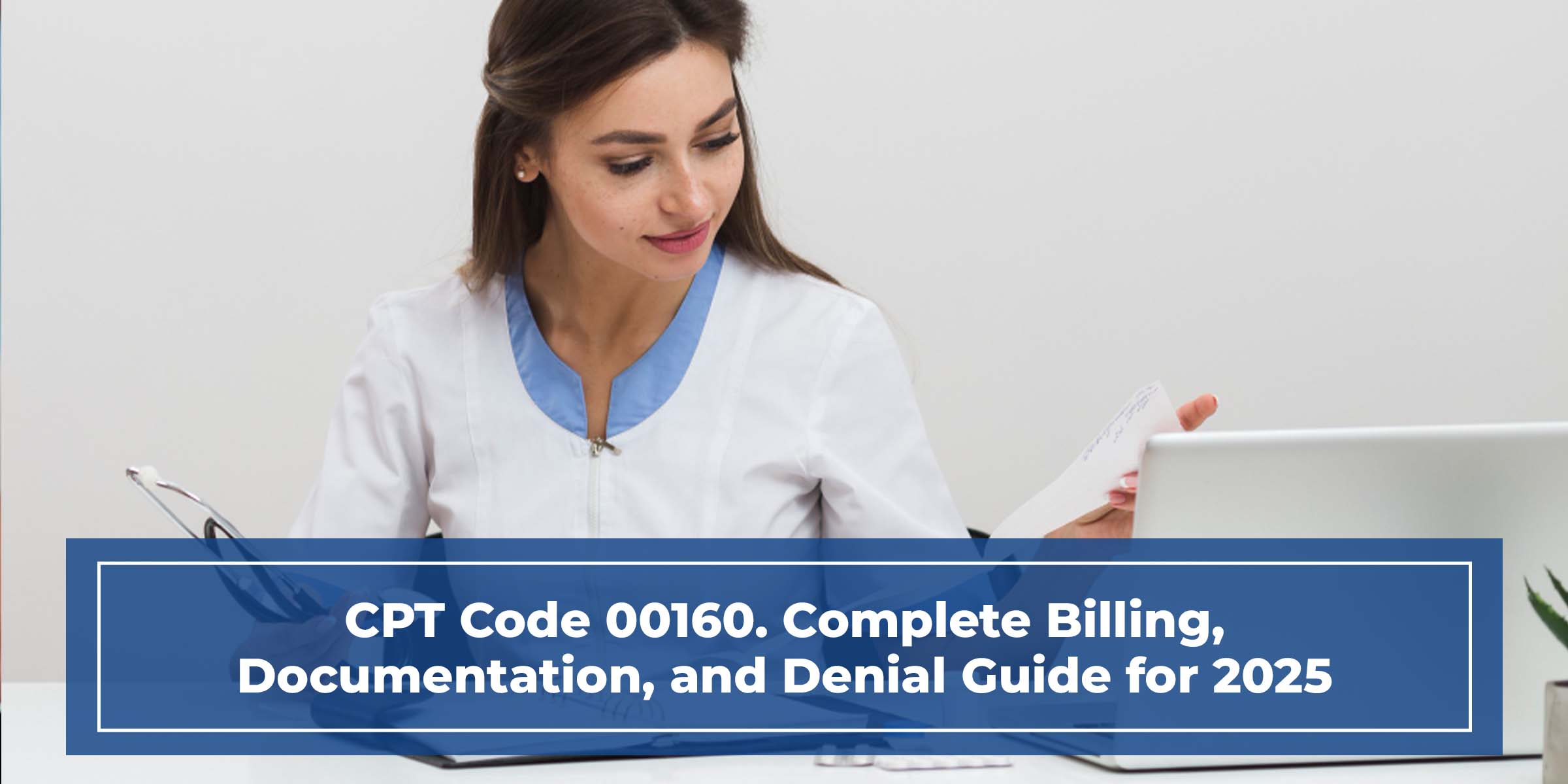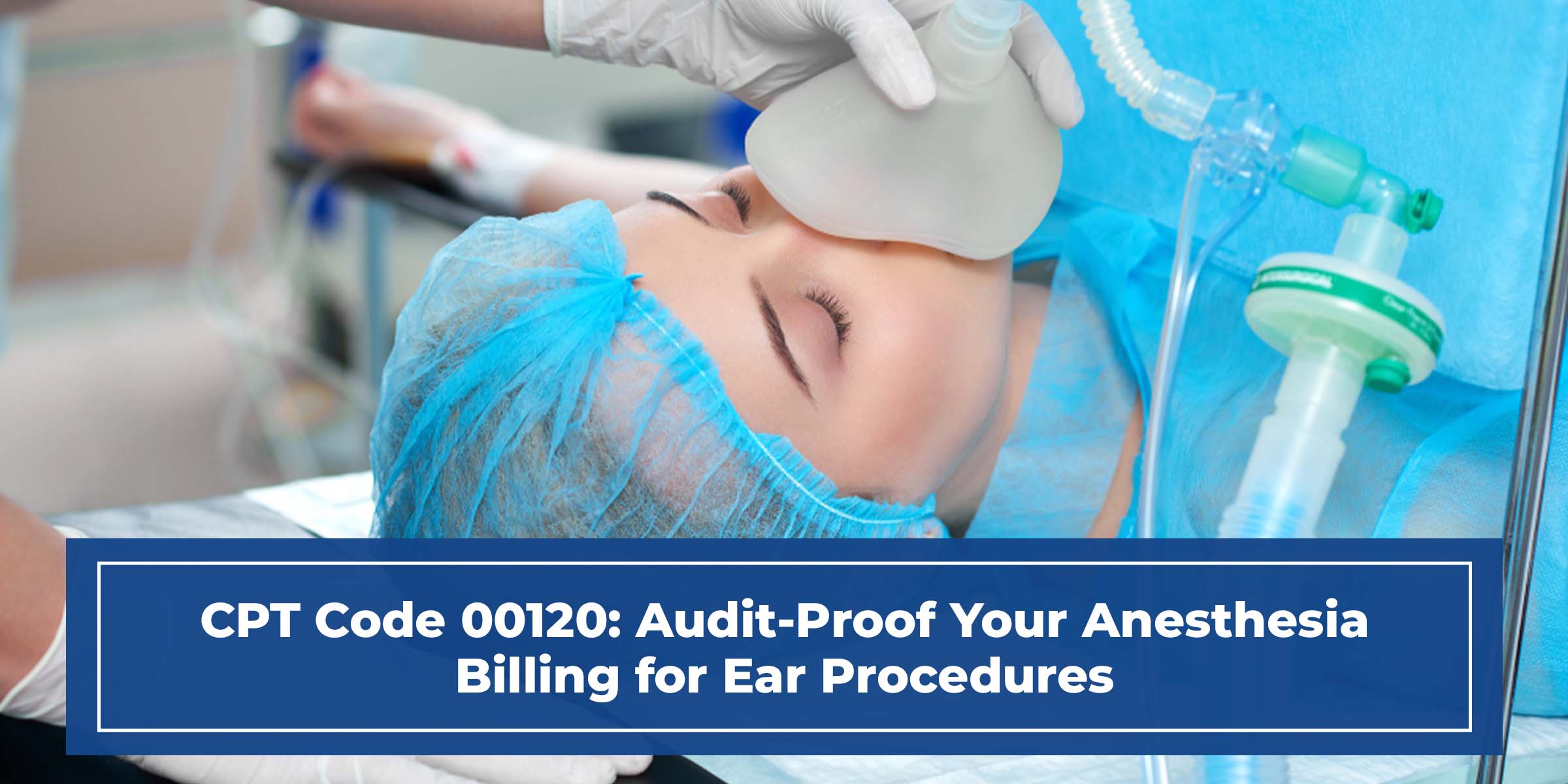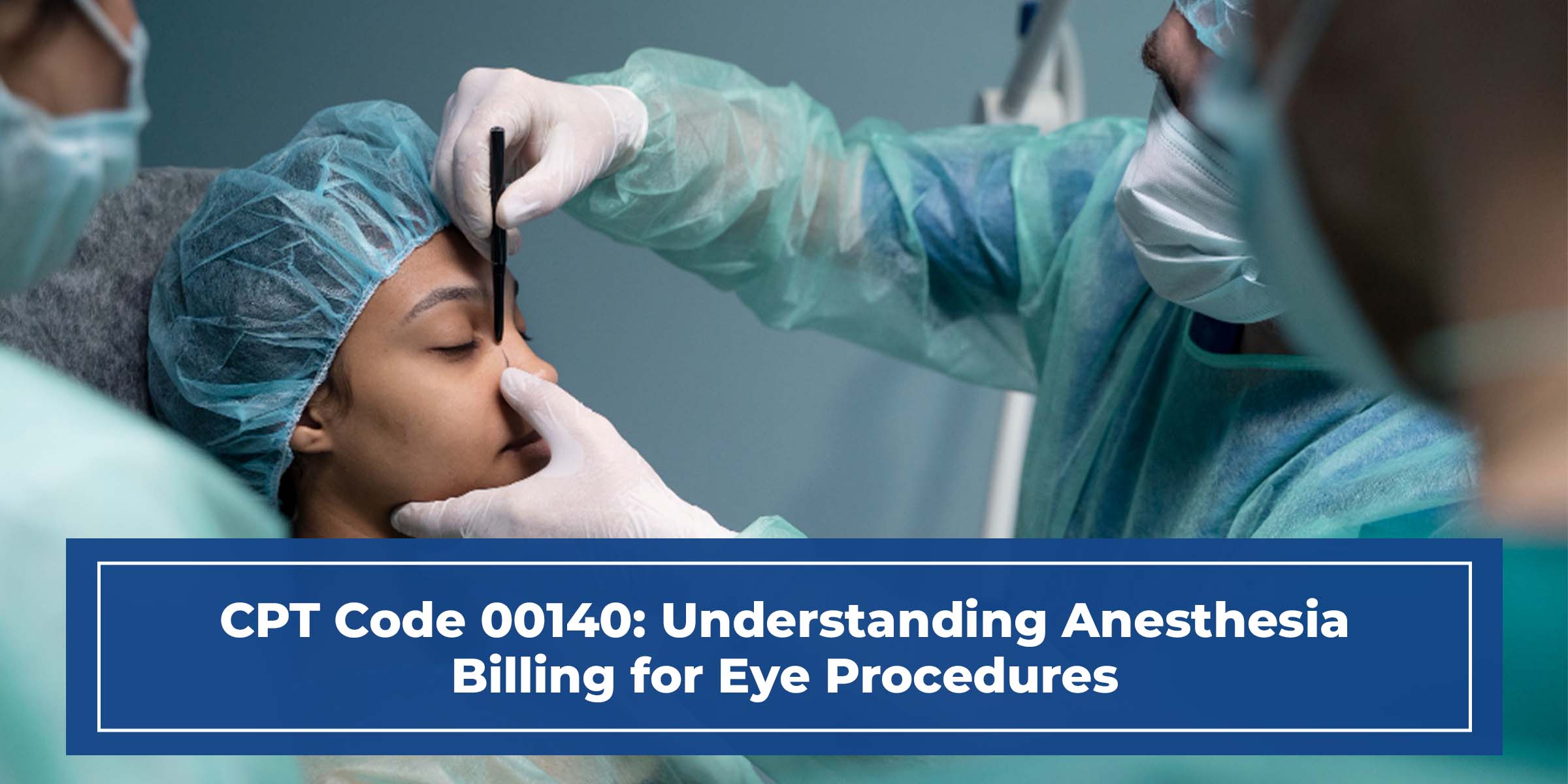Anesthesia billing for ENT procedures often seems simple—until denials pile up. One of the most misused yet highly billable anesthesia codes is CPT 00120. Billed incorrectly, it invites rejections from Medicare, Medicaid, and commercial payers alike. Billed with precision, it ensures fair payment for services tied to complex ear surgeries.
This guide provides a real-world, billing-first explanation of CPT 00120, including its definition, base unit data, modifier combinations, diagnosis pairing, and payer-specific strategies.
What Is CPT Code 00120?
CPT 00120 is defined as:
“Anesthesia for procedures on external, middle, and inner ear including biopsy.”
This code applies when a qualified provider delivers general anesthesia or monitored anesthesia care (MAC) for surgical interventions involving any part of the ear. It’s used for operations like:
- Myringoplasty
- Tympanoplasty
- Cochlear implantation
- ear biopsies
CPT 00120 should not be confused with moderate sedation or local anesthesia. It is strictly for deep sedation or general anesthesia managed by an anesthesiologist or CRNA.
Base Unit Reference and Billing Formula
Base Units: 5
This value is confirmed across national and state fee schedules, including VA and Massachusetts Medicaid. It represents the standard base unit value assigned to CPT 00120 across anesthesia fee schedules.
Time Units: Calculated in 15-minute increments based on documented anesthesia time from induction to emergence
Physical Status Units: P1–P6, depending on the patient’s ASA classification, with higher risk adding additional units
Conversion Factor (CF): Varies by payer and geographic region; updated quarterly for Medicare and negotiated differently for commercial plans
Formula:
(Base Units + Time Units + Physical Status Units) × Conversion Factor = Reimbursement
Always report exact anesthesia time in minutes. Do not round or convert to hours. Avoid estimates like “1.5 hours” and instead document as “90 minutes.”
Modifier Use With CPT 00120
Apply modifiers based on who administered anesthesia and under what conditions:
| Modifier | Meaning |
| AA | Anesthesiologist performed the entire case |
| QX | CRNA under supervision |
| QZ | CRNA working independently |
| QS | Monitored Anesthesia Care |
| P1–P6 | Patient condition – higher status adds units |
| 23 | Unusual anesthesia (e.g. conversion to GA mid-case) |
| U-modifier | Required in some Medicaid programs |
CPT 00120 Usage Across External, Middle, and Inner Ear Procedures
CPT 00120 supports anesthesia services across all ear regions. Documentation, ICD alignment, and modifier usage differ based on surgical anatomy and procedure type.
CPT 00120 for External Ear Surgeries
Procedures in this category often seem simple—but require anesthesia for patient cooperation or due to anatomical limitations.
Common Procedures:
- Wide local excision of skin lesion
- Biopsy of external auditory canal
- Keloid removal
- Cerumen removal under general anesthesia
- Repair of auricular lacerations
ICD-10 Codes:
- H61.23 – Impacted cerumen, bilateral
- D23.20 – Benign neoplasm of ear skin
- L91.0 – Hypertrophic scar
- L72.0 – Epidermoid cyst
- H60.3X – Malignant otitis externa
Billing Notes:
- Use modifier QZ if CRNA is unsupervised
- Apply P2 or P3 status for comorbid patients
- Claims with cerumen removal must explain why general anesthesia was necessary
CPT 00120 for Middle Ear Procedures
This is the most common clinical application of 00120 and includes surgeries where the tympanic membrane or ossicles are involved.
Common Procedures:
- Myringoplasty
- Tympanoplasty (with or without ossicular repair)
- Stapedectomy
- Ossiculoplasty
- Removal of cholesteatoma
ICD-10 Codes:
- H72.00 – Central perforation of tympanic membrane
- H80.01 – Otosclerosis involving oval window
- H73.0X – Tympanosclerosis
- H65.3X1 – Chronic serous otitis media
- D33.3 – Benign cranial nerve neoplasm
Billing Notes:
- Middle ear surgeries often require sedation exceeding 1 hour
- Time logs should reflect surgical duration accurately
- Add QS only when MAC is documented, not assumed
- P3 or P4 status applies in cases with systemic disease (e.g., hypertension, diabetes)
CPT 00120 for Inner Ear and Neurotologic Surgeries
Inner ear and skull base procedures involve higher risk, longer duration, and more intense anesthesia documentation. These cases are often reviewed in post-payment audit.
Common Procedures:
- Cochlear implant surgery
- Labyrinthectomy
- Vestibular nerve section
- Facial nerve decompression
- Mastoidectomy with posterior fossa access
ICD-10 Codes:
- H90.3 – Sensorineural hearing loss, bilateral
- Q85.03 – Neurofibromatosis type 2
- D33.3 – Acoustic neuroma
- H81.4 – Vestibular neuronitis
- H95.1 – Post-mastoidectomy complications
Billing Notes:
- Use modifier P4–P5 for patients with advanced risk
- Anesthesia time often exceeds 2 hours; document clearly
- Operative note and anesthesia record must match
- Modifier 23 is valid if anesthesia plan changed during case
Where CPT 00120 Claims Fail Most Often
| Denial Cause | Example | Fix |
| Modifier missing | CRNA billed without QZ/QX | Match modifier to role |
| Improper time | Rounded to “1.5 hours” | Use actual minutes |
| Weak ICD-10 | “H61.9” (unspecified ear disorder) | Use surgical justification |
| MAC claim missing QS | No documentation of monitored care | Ensure clinical note confirms MAC |
| Medicaid modifier absent | Claim lacks “U” in Texas | Check Medicaid rules by state |
How CPT 00120 Is Treated by Different Insurance Types
Each payer type has different rules and documentation expectations for anesthesia services. Even if the CPT and modifiers are correct, claims can still be denied if the payer-specific guidelines aren’t followed.
Medicare (MACs)
- Accepts CPT 00120 under standard anesthesia billing rules
- Requires exact time documentation from start to end
- Physical status modifiers (P1–P6) accepted but don’t add payment value
- MAC cases require QS; must be supported by charting
- Conversion Factor (CF) varies by region and quarter
- Claims over 120 minutes may trigger pre-pay audit
Pro Tip: Always confirm the local MAC’s current LCD or billing article. Modifier combinations (e.g., QZ + P3) must reflect documentation.
Medicaid
- Medicaid often mirrors Medicare structure but includes state-specific modifiers
- In Texas and several other states, modifier U is mandatory
- Medicaid may not reimburse QZ in some states unless CRNAs have direct billing authority
- Time reporting is strictly enforced
- Denials occur if documentation is “boilerplate” or lacks medical necessity
Pro Tip: Always check the state’s published provider manual and procedure-specific documentation requirements. Even minor omissions lead to denials.
Commercial Payers
- Require both the anesthesia record and the surgical op note in audits
- Medical necessity is often challenged for short-duration cases
- Time units exceeding 8 units (2 hours) are often flagged
- Some payers require pre-authorization for cochlear or neurotologic procedures
- Modifier QX or QZ must match documentation; mismatches often go unnoticed until post-payment review
Pro Tip:
Maintain a payer-specific modifier and documentation checklist. Update quarterly based on EOB patterns.
If your practice struggles with denials, payer-specific modifier rules, or revenue leakage in anesthesia billing, our Anesthesia RCM services can help optimize compliance and ensure faster payments.
Checklist Before You Submit CPT 00120
Use this final checklist to ensure your CPT 00120 submission meets documentation, modifier, and payer-specific requirements before claims go out.
- CPT 00120 confirmed for qualifying ENT procedure
- 5 base units applied
- Time logged in minutes
- Physical status modifier present (P1–P6)
- Correct provider modifier used (AA, QZ, QX)
- Diagnosis linked to procedure
- Special Medicaid modifiers added if required
- Op report and anesthesia record align
Final Note
CPT 00120 should be easy to bill—but only if the structure behind it is sound. Treat each submission like an audit file. Your diagnosis must support your code. Your provider must match the modifier. Your time must be exact. Your documentation must stand on its own.
That’s how 00120 gets paid the first time—without appeals, rejections, or takebacks.





